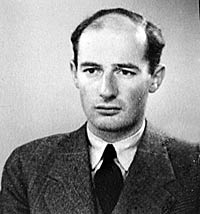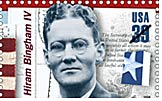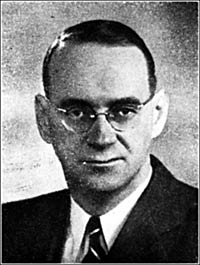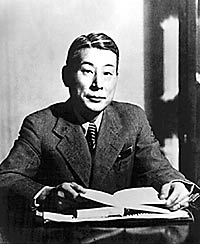Readings:
Psalm 11
Joshua 2:1-21
Colossians 3:1-4
John 19:10-15Preface of a Saint (2)
[Common of a Saint]
[For Social Justice]
[For Prophetic Witness in Society]
PRAYER (traditional language)
Lord of the Exodus, who dost deliver thy people with a strong hand and a mighty arm: Strengthen thy Church with the examples of the Righteous Gentiles of World War II to defy oppression for the rescue of the innocent; through Jesus Christ our Lord, who liveth and reigneth with thee and the Holy Spirit, one God, now and for ever. Amen.
PRAYER (contemporary language)
Lord of the Exodus, who delivers your people with a strong hand and a mighty arm: Strengthen your Church with the examples of the Righteous Gentiles of World War II to defy oppression for the rescue of the innocent; through Jesus Christ our Lord, who lives and reigns with you and the Holy Spirit, one God, now and for ever. Amen.
This commemoration appears in A Great Cloud of Witnesses.
Return to Lectionary Home Page
Webmaster: Charles Wohlers
Last updated: 16 May 2020
“THE RIGHTEOUS GENTILES”
Although the phrase "Righteous Gentiles" has become a general term for any non-Jew who risked their life to save Jews during the Holocaust, it here appears to apply specifically to: Raoul Wallenberg [Swedish, d. 1947] Hiram Bingham IV [d. 1988, American]; Karl Lutz [d. 1975, Swiss]; C. Sujihara [d. 1986, Japanese]; and Andre Trocme [d. 1971, French].
 Raoul
Wallenberg (August 4, 1912 – July 17, 1947?) was a Swedish
humanitarian who worked in Budapest, Hungary, during World War II to rescue
Jews from the Holocaust. Between July and December 1944, he issued protective
passports and housed Jews, saving tens of thousands of Jewish lives.
Raoul
Wallenberg (August 4, 1912 – July 17, 1947?) was a Swedish
humanitarian who worked in Budapest, Hungary, during World War II to rescue
Jews from the Holocaust. Between July and December 1944, he issued protective
passports and housed Jews, saving tens of thousands of Jewish lives.
On January 17, 1945, he was arrested in Budapest by the Soviets after they wrested control of the city from the Germans, and was reported to have been executed while a prisoner at Lubyanka Prison, although this is not entirely certain.
Wallenberg has been honored numerous times. He is an honorary citizen of the United States, Canada, Hungary and Israel. Israel has also designated Wallenberg one of the Righteous among the Nations. Monuments have been dedicated to him, and streets have been named after him throughout the world.
— more at Wikipedia
 Hiram
"Harry" Bingham IV (July 17, 1903 – January 12,
1988) was an American diplomat. He served as a Vice-Consul in Marseille,
France, during World War II, and helped over 2,500 Jews to flee from France
as Nazi forces advanced.
Hiram
"Harry" Bingham IV (July 17, 1903 – January 12,
1988) was an American diplomat. He served as a Vice-Consul in Marseille,
France, during World War II, and helped over 2,500 Jews to flee from France
as Nazi forces advanced.
In 1939, Bingham was posted to the US Consulate in Marseille, where he, together with another vice-consul named Myles Standish, was in charge of issuing entry visas to the USA.
On June 10, 1940, Adolf Hitler's forces invaded France and the French government fell. Several influential Europeans tried to lobby the American government to issue visas so that German and Jewish refugees could freely leave France and escape persecution.
Anxious to limit immigration to the United States and to maintain good relations with the Vichy government, the State Department actively discouraged diplomats from helping refugees. However, Bingham cooperated in issuing visas and helping refugees escape France. Hiram Bingham gave about 2,000 visas, most of them to well-known personalities, speaking English, including Max Ernst, André Breton, Hannah Arendt, Marc Chagall, Lion Feuchtwanger and Nobel prize winner Otto Meyerhof.
— more at Wikipedia
 Carl
Lutz (b. Walzenhausen, 30 March 1895; d. Berne, 12 February 1975)
was the Swiss Vice-Consul in Budapest, Hungary from 1942 until the end of
World War II. He helped save the lives of tens of thousands of Jews from
deportation to Nazi Extermination camps during the Holocaust.
Carl
Lutz (b. Walzenhausen, 30 March 1895; d. Berne, 12 February 1975)
was the Swiss Vice-Consul in Budapest, Hungary from 1942 until the end of
World War II. He helped save the lives of tens of thousands of Jews from
deportation to Nazi Extermination camps during the Holocaust.
Lutz immigrated at the age of 18 to the United States, where he was to remain for more than 20 years. Lutz’s sojourn in the United States ended with his assignment as vice-consul to the Swiss Consulate General in Jaffa, in what was then Palestine.
Appointed in 1942 as Swiss vice-consul in Budapest, Hungary, Lutz soon began cooperating with the Jewish Agency for Palestine, issuing Swiss safe-conduct documents enabling Jewish children to emigrate.
Once the Nazis took over Budapest in 1944 and began deporting Jews to the death camps, Lutz negotiated a special deal with the Hungarian government and the Nazis: he had permission to issue protective letters to 8,000 Hungarian Jews for emigration to Palestine. Lutz then deliberately misinterpreted his permission for 8,000 as applying to families rather than individuals, and proceeded to issue tens of thousands of additional protective letters, all of them bearing a number between one and 8,000. He also set up some 76 safe houses around Budapest, declaring them annexes of the Swiss legation. Among the safe houses was the now well-known "Glass House" (Üvegház) at Vadász Street 29. About 3,000 Jews found refuge at the Glass House and in a neighboring building.
— more at Wikipedia
 Chiune
Sugihara (1 January 1900 – 31 July 1986) was a Japanese
diplomat, serving as Vice Consul for the Japanese Empire in Lithuania.
During World War II, he helped several thousand Jews leave the country
by issuing transit visas to Jewish refugees so that they could travel
to Japan. Most of the Jews who escaped were refugees from German-occupied
Poland or residents of Lithuania. Sugihara wrote travel visas that facilitated
the escape of more than 6,000 Jewish refugees to Japanese territory, risking
his career and his family's life.
Chiune
Sugihara (1 January 1900 – 31 July 1986) was a Japanese
diplomat, serving as Vice Consul for the Japanese Empire in Lithuania.
During World War II, he helped several thousand Jews leave the country
by issuing transit visas to Jewish refugees so that they could travel
to Japan. Most of the Jews who escaped were refugees from German-occupied
Poland or residents of Lithuania. Sugihara wrote travel visas that facilitated
the escape of more than 6,000 Jewish refugees to Japanese territory, risking
his career and his family's life.
When asked why he did it, he responded:
“You want to know about my motivation, don't you? Well. It is the kind of sentiments anyone would have when he actually sees refugees face to face, begging with tears in their eyes. He just cannot help but sympathize with them. Among the refugees were the elderly and women. They were so desperate that they went so far as to kiss my shoes, Yes, I actually witnessed such scenes with my own eyes. Also, I felt at that time, that the Japanese government did not have any uniform opinion in Tokyo. Some Japanese military leaders were just scared because of the pressure from the Nazis; while other officials in the Home Ministry were simply ambivalent.
People in Tokyo were not united. I felt it silly to deal with them. So, I made up my mind not to wait for their reply. I knew that somebody would surely complain about me in the future. But, I myself thought this would be the right thing to do. There is nothing wrong in saving many people's lives .... The spirit of humanity, philanthropy ... neighborly friendship ... with this spirit, I ventured to do what I did, confronting this most difficult situation ---and because of this reason, I went ahead with redoubled courage. ”
When asked why he risked his career to save other people, he quoted an old samurai saying: "Even a hunter cannot kill a bird which flies to him for refuge."
— more at Wikipedia
 André
Trocmé ( April 7, 1901 – June 5, 1971) and his wife
Magda (née Grilli di Cortona, November 2, 1901,
Florence, Italy - Oct. 10, 1996) are a couple of French Righteous Among
the Nations. For 15 years, André served as a pastor in the town
of Le Chambon-sur-Lignon on the Plateau Vivarais-Lignon in South-Central
France. He had been sent to this rather remote parish because of his pacifist
positions which were not well received by the French Protestant Church.
In his preaching he spoke out against discrimination as the Nazis were
gaining power in neighboring Germany and urged his Protestant Huguenot
congregation to hide Jewish refugees from the Holocaust of the Second
World War.
André
Trocmé ( April 7, 1901 – June 5, 1971) and his wife
Magda (née Grilli di Cortona, November 2, 1901,
Florence, Italy - Oct. 10, 1996) are a couple of French Righteous Among
the Nations. For 15 years, André served as a pastor in the town
of Le Chambon-sur-Lignon on the Plateau Vivarais-Lignon in South-Central
France. He had been sent to this rather remote parish because of his pacifist
positions which were not well received by the French Protestant Church.
In his preaching he spoke out against discrimination as the Nazis were
gaining power in neighboring Germany and urged his Protestant Huguenot
congregation to hide Jewish refugees from the Holocaust of the Second
World War.
In 1938, André Trocmé and Reverend Edouard Theis founded the Collège Lycée International Cévenol in Le Chambon-sur-Lignon, France. Its initial purpose was to prepare local country youngsters to enter the university. When the refugees arrived, it also took in many Jewish young people wishing to continue their secondary education.
When France fell to Nazi Germany, the mission to resist the Nazis became increasingly important. Following the establishment of the Vichy France regime during the occupation, Trocmé and his church members helped their town develop ways of resisting the dominant evil they faced. Together they established first one, and then a number of "safe houses" where Jewish and other refugees seeking to escape the Nazis could hide. Many refugees were helped to escape to Switzerland following an underground railroad network. Between 1940 and 1944 when World War II ended in Europe, it is estimated that about 3500 Jewish refugees including many children were saved by the small village of Le Chambon and the communities on the surrounding plateau because the people refused to give in to what they considered to be the illegitimate legal, military, and police power of the Nazis.
— more at Wikipedia